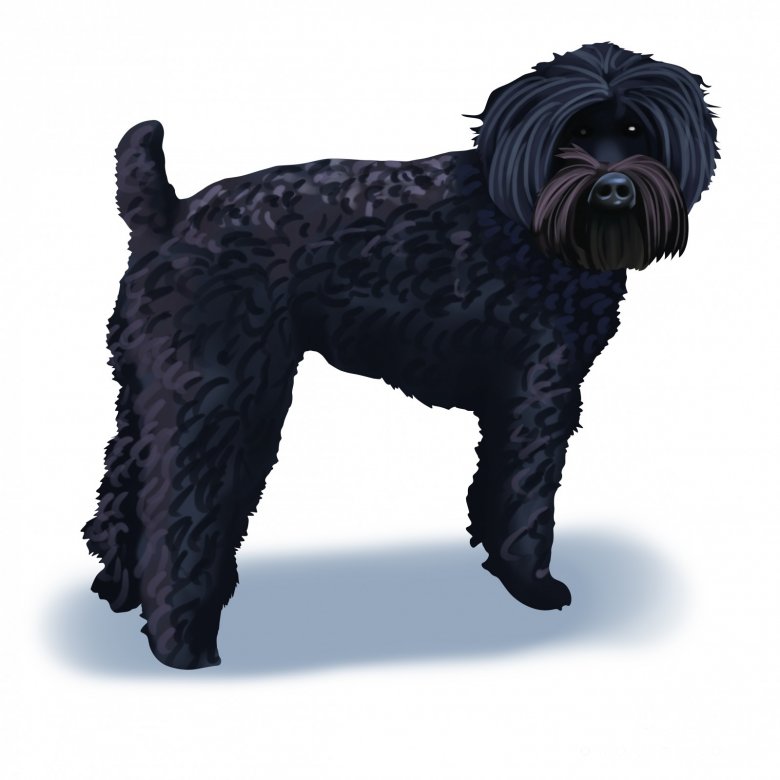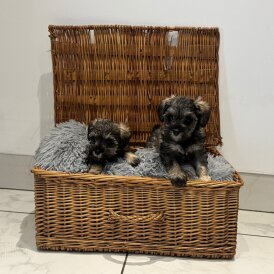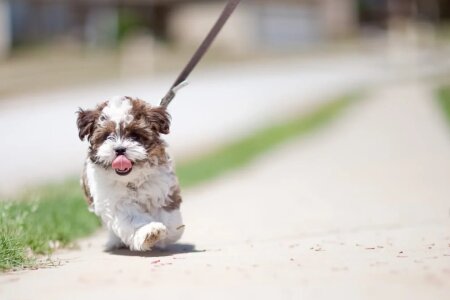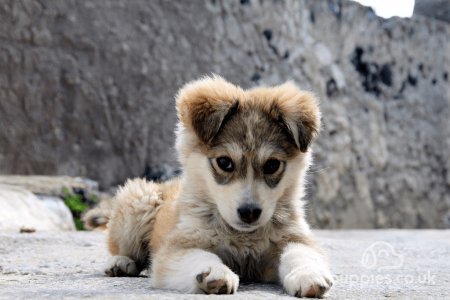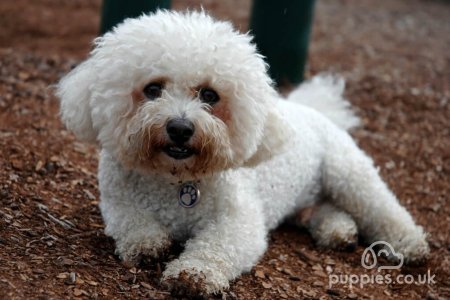Schnoodle
Overview
If you are searching for a fun, loving, and adaptable dog, look no further than the Schnoodle. With this breed’s intelligence and temperament, the Schnoodle makes a fantastic companion for an individual or a family. They are often caught online in videos with them zooming around a room doing the Schnoodle ‘Butt Tuck’, whizzing around in a circle very quickly, which is a fitting example that shows exactly how these dogs can be. In the last 10 - 20 years, this breed has grown massively in popularity due to the appealing characteristics of this hybrid.
Highlights:
With both the Poodle and the Schnauzer being hypoallergenic breeds, the Schnoodle follows suit in being low shedding and therefore hypoallergenic. However, this does not mean they are not high maintenance to groom;
Due to their inheritance, the Schnoodle can be bred in a variety of sizes, from Giant to Toy size. Therefore, you are able to find a dog that fits your needs directly dependent on your space and living arrangements;
Schnoodles have a very good sense of smell, and therefore can be taught to look for certain smells with the correct training. This can be useful in all sorts of areas in life, including sniffer dogs for police and support dogs.
Physical Appearance
One of the benefits of a hybrid breed is that prospective owners can choose what size they want their dog to grow up to be. This can also be seen in the Schnoodle, with there being 3 main different sizes.
Firstly, the giant Schnoodle can stand around 60-68cm at the withers, whereas their toy counterpart would measure around 25-30cm. Another size that can be seen is the Miniature Schnoodle, falling between 30-38cm. Finally, the standard Schnoodle stands at 38-66cm, being slightly smaller than the giant size of this breed. This range in height also affects the weight of your dog, with the larger it gets, the heavier it weighs.
However, this variety in their height does mean that their popularity increases correspondingly, so multiple people with different living arrangements can benefit from this breed. Usually, the smaller versions of this breed have a petite build, their rounder face and floppy ears helping to maintain their puppy-like appearance all throughout their life. As they get bigger, Schnoodles can often look different.
This is also linked to the characteristics the puppy gets from their parents. If the dog is more similar to the Schnauzer, they will have a more stocky build and rectangular face, whereas the Poodle ancestry could leave the puppy with a slighter structure and possibly a more pointy face. Although owners might be looking for a specific appearance for their Schnoodle, it is important to remember that it is difficult for breeders to know which characteristics the puppy will get from their parents. As well as their varying sizes, Schnoodles can be seen in many different colours, including apricot, black, white and brown.
How big do Schnoodle dogs get?
Height:
Toy Schnoodles: 25 - 30cm
Miniature Schnoodles: 30 - 38cm
Standard Schnoodles: 38 - 60cm
Giant Schnoodles: 60 - 68cm
Weight:
Toy Schnoodles: 3 - 5kg
Miniature Schnoodles: 6 - 9kg
Standard Schnoodles: 10 - 20kg
Giant Schnoodles: 25 - 48kg
Character Traits
Schnoodles are known to be the perfect family companions, loving attention and affection as well as running around playing fetch. Whilst this breed is energetic, they are intelligent enough to realise when downtime is. Most of the time, however, it is the smaller Schnoodles that are the most affectionate, with the larger versions of this breed having more aggression towards strangers or other dogs.
As a puppy, early socialisation for your Schnoodle is of paramount importance so they become accustomed to the world around them and other animals, meaning they won’t be scared or act differently towards dogs they cross on the street. However, it is important to remember that this cannot be said of all Schnoodles and it is very difficult to see whether your puppy will inherit some aggressive characteristics or not.
During training, instead of getting angry towards your dog when they do not do as they are asked, Schnoodles respond well to positive reinforcement. As well as a kind approach to training, Schnoodles typically are a stubborn breed that tend to ignore their owners when it suits them. Therefore, remember to be clear in your commands and consistent with training, as they can become extremely obedient when this is performed correctly.
The mix between the Poodle’s and the Schnauzer’s alert nature means that Schnoodle dogs often make very good guard dogs, barking at strangers or when they feel something is out of place. So, if you are looking for a dog to keep you safe and a loyal companion that loves to play, you are on the right track with the Schnoodle.
Are Schnoodle dogs affectionate? - Yes.
Do Schnoodle dogs have high or low energy levels? - Moderate, but they will always be up for a play or another walk.
Are Schnoodle dogs loyal? - Yes.
Are Schnoodle dogs playful? - Yes.
Are Schnoodle dogs aggressive? - No, but temperament differs with their size.
Are Schnoodle dogs easy to train? - Yes, but they can be stubborn.
Are Schnoodle dogs good guard dogs? - Yes.
Ability to Socialise
The most important thing you can do for your Schnoodle is to socialise them from an early age with people, other dogs and other animals. Once they have this basis of understanding, this breed will be able to adapt to any new moment in life without you worrying about how they will take it. Without this, it can be common for the Schnoodle to have a negative approach to smaller animals, seeing them as prey rather than a friend.
It is important to remember that without the correct introduction, your Schnoodle could be aggressive towards other dogs, which would make going on walks in the park or even going down the street to the shops a chore rather than an enjoyable experience. Having said this, however, Schnoodles tend to get on very well with small children.
Due to this breed loving the attention, being around children is perfect. Although it may take some time for your Schnoodle to get used to its surroundings, you can be sure that your dog will be a loyal, fun and safe companion for your family.
Do Schnoodle dogs get along with other pets? - Yes, when introduced properly.
Do Schnoodle dogs get along with other dogs? - Yes, when introduced properly.
Are Schnoodle dogs good with kids? - Yes.
Are Schnoodle dogs good with strangers? - No.
Lifestyle Suitability
Due to their adaptable nature, Schnoodles are more or less suitable for anyone. They are relatively clean dogs, not prone to drooling and are hypoallergenic. Although they can easily fit into a variety of lifestyles, it is important to remember that Schnoodles still require enough exercise and playtime to maintain mental stimulation.
Their intelligence and keenness to learn make them easy to train, and therefore this breed is a good choice for first-time owners. With their affectionate and eager-to-please personality, they are all around a lovely dog to own. However, their guard dog nature does mean that they occasionally like to use their voices to show their emotions about someone or something in their surroundings.
It is important to not let this habit continue and you should be wary to nip it in the bud sooner rather than later so you are not left with a yappy dog in the future. Schnoodles should not really be left at home due to their mischievous nature. Once they get bored, they work to find what they love most: food. This breed is known for climbing up onto surfaces where they can smell something delicious, so owners must be conscious of putting their leftovers in the bin and putting everything back in a container.
Furthermore, this breed suffers from separation anxiety when by themselves for too long, which should also be taken into account when planning to own a Schnoodle. Whilst these dogs are adaptable, they are not suited to a household where they are repeatedly left alone for hours at a time.
Are Schnoodle dogs good for first-time owners? - Yes.
Are Schnoodle dogs hypoallergenic? - Yes.
Are Schnoodle dogs prone to drooling? - No.
Are Schnoodle dogs a good breed for apartment living? - Yes.
Do Schnoodle dogs shed a lot? - No.
Do Schnoodle dogs bark a lot? - Yes.
Can Schnoodle dogs be left alone at home? - No.
Can Schnoodle dogs handle the heat? - Yes.
Can Schnoodle dogs handle cold temperatures? - Yes.
Are Schnoodle dogs sensitive to loud noises? - Yes.
General Health & Health Issues
Due to Schnoodles constantly searching for food and asking for leftovers, this breed is prone to obesity. Unfortunately, in addition to weight gain, Schnoodles can be susceptible to a wide range of health conditions.
Cataracts: This health issue is in regards to the dog’s eyes, where they develop difficulties in their vision, usually developing at later stages. It is recommended that owners get their Schnoodle’s eyes tested on a regular basis to check for any problems, especially when they get older.
Patellar Luxation
Epilepsy
Diabetes Mellitus
Addison’s Disease
Gastric Torsion
How long do Schnoodle dogs live? - 10-15 years
Exercise & Play Time
Although the recommended time for Schnoodles to exercise is up to 1 hour per day, these dogs are very happy to run around for as long as they are allowed. It is important that Schnoodles get time off the lead where they can be independent, following smells and meeting new dogs.
Across all the different Schnoodle sizes, this breed is extremely energetic, and will benefit from even more walking and playing if they can get it! On top of this, Schnoodles adore water and enjoy nothing more than a game of fetch at the beach.
However, as with most puppies, owners should take care in introducing their dog to water in a safe and supportive way so that they enjoy swimming, instead of their puppy becoming fearful of water after being pressured into it.
How much exercise does a Schnoodle dog need? - 20 minutes - 1 hour per day
Do Schnoodle dogs like water play? - Yes
Nutrition & Feeding
As Schnoodles are susceptible to weight gain, these dogs must have a more specific and controlled diet, with the correct amount of minerals and vitamins so that they can maintain their health and reduce the possibility of them having illnesses. It is also important to consult your vet, as the variety of sizes of this breed can mean that there will be different amounts of food that they should be given.
Furthermore, owners should be conscious of not giving their Schnoodle too many treats or leftovers from their own meals, as this will increase their weight very quickly.
Are Schnoodle dogs prone to weight gain? - Yes.
How much should I feed a Schnoodle puppy? - 3 - 4 small meals a day.
How much should I feed an adult Schnoodle dog? - 2 larger meals a day.
Care & Maintenance
Although Schnoodles are hypoallergenic and do not shed their coat, they have extremely demanding grooming needs. As they have long and curly coats, they often get knots that end up matting their fur very quickly, as well as growing over their eyes and blocking their vision.
Owners must remain up to date with getting their coats cut, especially in the face area and anywhere that is long enough to touch the ground and pick up dirt. It is recommended that these dogs are brushed 3-4 times a week to remove any matting, as well as being brought to the groomers every 4-6 weeks for a trim and a wash.
Schnoodles have coats that are prone to picking up dirt, so it is important that they are not left with dirty fur, which could possibly lead to skin diseases and other problems.
History of the Schnoodle
Becoming popular in the last decade, the Schnoodle is a new breed that has stolen the hearts of many since its first sightings. This breed was created in 1980 in the US after the demand for a hypoallergenic, friendly and adaptable dog was increasing.
Although their ancestry is not clear, the Schnoodle is a hybrid dog mix of a Poodle and a Schnauzer. Interestingly, The Kennel Club does not recognise the Schnoodle as a breed, however, these dogs are still accepted to participate in agility and obedience competitions due to their hybrid nature.
Interesting Facts About Schnoodle Dogs
Schnoodles make very good agility and obedience dogs, often being seen in competitions and contests and sometimes placing highly;
As Schnoodles are a hybrid breed, each dog can be unique, taking different characteristics from each parent. This could affect their coat, their temperament, their size and their colour;
This breed is extremely adaptable and therefore will fit around you, instead of you having to fit around your Schnoodle. This characteristic makes them very admirable for those living in cities or in smaller flats;
Schnoodle puppies tend to be extremely high in energy, but this breed is known to calm down once they are grown up.
Getting a Schnoodle Puppy
Before buying any puppy, owners must be aware of the process of doing so. Please consult our buying guide to get further information on buying a dog, whether you are an experienced owner or a first-time buyer. Furthermore, it used to be common practice to dock a Schnoodle’s tail. Today, this has now become a banned practice. Therefore, owners must be conscious of this when looking at different litters, as the breeder’s legitimacy may be questioned if their tails are docked.
It is also important to be aware of scams on the internet. As Schnoodles are popular dogs, there will be many scams and fake adverts online for potential buyers to be tricked into. Owners must take time to visit the breeders and see the puppies before any money is transferred.
How much does a Schnoodle cost to buy? - £700 - £1000
How much does a Schnoodle cost to feed? - £30 - £50 per month
How much does insurance for a Schnoodle cost? - Around £50 per month
As exciting as getting a new puppy is, it can be a lot of work. So, you should also consider looking at these links that show adoption and rescue centres that have Schnoodles waiting - they could be the perfect dog for you.
Rescue and Rehoming Dogs
Dogs Trust is a wonderful charity that helps to raise awareness about rehoming and rescuing dogs. Schnoodles often get seen on the website, so it is worth keeping an eye out.
Rehoming a Dog
Further information on rehoming or adopting a dog with Battersea Dogs and Cats. Based in London, it is the perfect place for you to go and see whether this breed is the right one for you.






